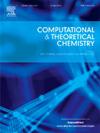Study on the sensitivity of transition metal-modified WO3 materials toward triethylamine and H2S gases in food safety by density functional theory
IF 3
3区 化学
Q3 CHEMISTRY, PHYSICAL
引用次数: 0
Abstract
The corrupt triethylamine gas and H2S gas in food safety pose a threat to food and human health. The development of efficient gas sensing materials can sensitively monitor these gases to ensure the safe development of the food industry. In this study, the sensitivity mechanism of transition metal Me (Me = Co, Fe, Mn, Ni) modified WO3-based sensors was systematically investigated based on density functional theory (DFT). By calculating the adsorption energy, electronic structure and charge transfer characteristics of gas molecules on the modified WO3 surface, it is found that the introduction of transition metal Me significantly enhances the chemical adsorption capacity of WO3 for triethylamine and H2S, and has higher charge transfer ability for H2S and TEA. The analysis of electron density of states shows that the synergistic effect of Me metal and WO3 interface reduces the valence band of WO3–002 composite material and transforms into conductor. There are free electrons near Me atom, forming metal‑oxygen bonds with surrounding O atoms, which is more conducive to the migration of electrons. This change is more conducive to the adsorption of gas molecules and improves the selectivity of gas recognition. The transition metal modification strategy can effectively optimize the performance of WO3-based sensors. This study provides a new idea for the design of food safety rapid detection devices.

用密度泛函理论研究过渡金属改性WO3材料对食品安全中三乙胺和H2S气体的敏感性
食品安全中腐败的三乙胺气体和H2S气体对食品和人体健康构成威胁。开发高效的气敏材料可以灵敏地监测这些气体,保证食品工业的安全发展。本研究基于密度泛函理论(DFT)系统研究了过渡金属Me (Me = Co, Fe, Mn, Ni)修饰wo3基传感器的敏感机理。通过计算改性WO3表面气体分子的吸附能、电子结构和电荷转移特性,发现过渡金属Me的引入显著增强了WO3对三乙胺和H2S的化学吸附能力,对H2S和TEA具有更高的电荷转移能力。态电子密度分析表明,金属Me与WO3界面的协同作用降低了WO3 - 002复合材料的价带,转变为导体。Me原子附近有自由电子,与周围的O原子形成金属-氧键,更有利于电子的迁移。这种变化更有利于气体分子的吸附,提高了气体识别的选择性。过渡金属改性策略可以有效地优化wo3基传感器的性能。本研究为食品安全快速检测装置的设计提供了新的思路。
本文章由计算机程序翻译,如有差异,请以英文原文为准。
求助全文
约1分钟内获得全文
求助全文
来源期刊

Computational and Theoretical Chemistry
CHEMISTRY, PHYSICAL-
CiteScore
4.20
自引率
10.70%
发文量
331
审稿时长
31 days
期刊介绍:
Computational and Theoretical Chemistry publishes high quality, original reports of significance in computational and theoretical chemistry including those that deal with problems of structure, properties, energetics, weak interactions, reaction mechanisms, catalysis, and reaction rates involving atoms, molecules, clusters, surfaces, and bulk matter.
 求助内容:
求助内容: 应助结果提醒方式:
应助结果提醒方式:


